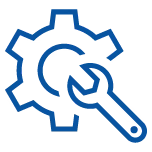1. WARRANTY, SERVICE - SUPPORT, & RETURNS - REFUNDS RELATED
Q: What about servicing and maintenance?
Servicing and maintenance is pretty easy and simple. It's mostly DIY( Do-It-Yourself). Or any local mechanic or an electrican will be able to fix any minor challenges. We will always be available for quick WhatsApp video call to analyse the issue and suggest recommended steps for resolving the issue.
The machine construction is modular in nature. Meaning each and every part can be either serviced or replaced.
Q: Will a technician visit our facility for servicing and maintenance? How does it work? What's the cost associated with the servicing?
No, there will be no technician visiting the customer's residence. It's easy to remove the defective part and send it back to us. We'll diagnose the issue and repair it or replace the parts/components. We mostly have spare parts in-stock and we'll be able to quickly send a replacement in case of a requirement. After the warranty period, the repair-replacement depending on the issue will cost approximately Rs. 4000-5000 including shipping, processing, and taxes.
Q: What's the manufacturing warranty and what are the servicing costs?
The system comes with a lifetime guarantee and a 1-year manufacturing warranty. Any defective component in the system during this period will be replaced and repaired at free of cost. Springs are not covered under manufacturing warranty. Springs need timely replacement.
***International customers need to send back the defective parts at their own cost while the servicing and replacement will be done at no cost.
Q: And in case of repairs do you have any support PAN India and outside?
We provide virtual service and support throughout the world. Servicing assistance over a WhatsApp video call will be provided to diagnose the issue and further action will be recommended based on the observations.
2. PRODUCT TECHNICALITIES
Q: How much does the product weigh?
Packaged weighs 30kgs. Unpackaged weighs 25kgs.
Q: What kind of balls can you use?
You can use any and all types of cricket balls - old, new, hard, soft, leather, synthetic, tennis, rubber as long it's in the size of a cricket ball and that fits the auto ball feeder. Avoid using out of shape and old balls.
Q: How many balls can you feed at once?
You can feed up to 10-12 balls at once in NON ELECTRIC.
Q: What's the maximum speed? Speed variable range?
Yes, you can vary the speeds, line, length, angles, and swing to suit your needs.
One can vary the speeds between 80-130KMPH. The machine can "simulate" speeds up to 80-130KMPH from 18 yards. It's a general practice to place the machine a yard or two closer to the batsman to generate speeds higher than 130kmph. Or farther away from the batter to simulate speeds lower that 80KMPH.
Q: Can you adjust the line, length and swing?
You can also vary the length, line, angles and partially control the ball's swing (in-swing and out-swing) according to batsmen's requirements. You need to adjust the ball throwing cup's angle to vary the length. And move the machine to change the orientation either left or right by tapping/kicking it by a few millimeters to change the direction of the ball throw and its line. By placing the ball in the ball throwing cup at various angles, pointing towards the third man or fine leg, you can partially vary the swings. Also, stimulate the ball's line either over or around the wicket bowling by merely aligning the machine to the batsman's right or left.
Q: What additional components are needed to make this work?
Nothing more. Just make sure you fill the sand bag provided along with the machine with sand as a counter balance weight. This arrangement to be made before using the machine to put it at the bottom of the machine for stability and consistent ball throwing. The counter balance should be minimum 40-50kgs and recommended to use sand bags as it's the best for vibration absorption. But one can use weight plates and filled water can.
3. SAFETY RELATED
Q: Does it come with a protective net?
It doesn't come with a protective net. It's advisable to use protective net in front of the machine to avoid any accidental damage by the batsman hitting balls back to the machine. It's advisable for the operator to wear helmet during all times of the operation.






